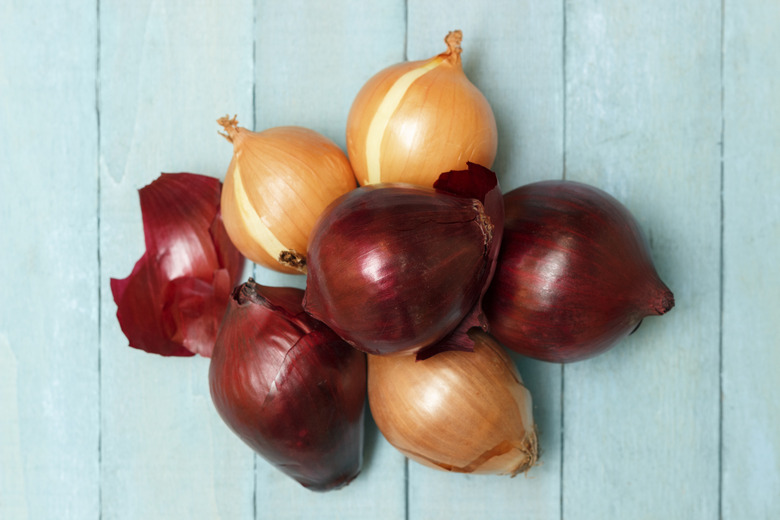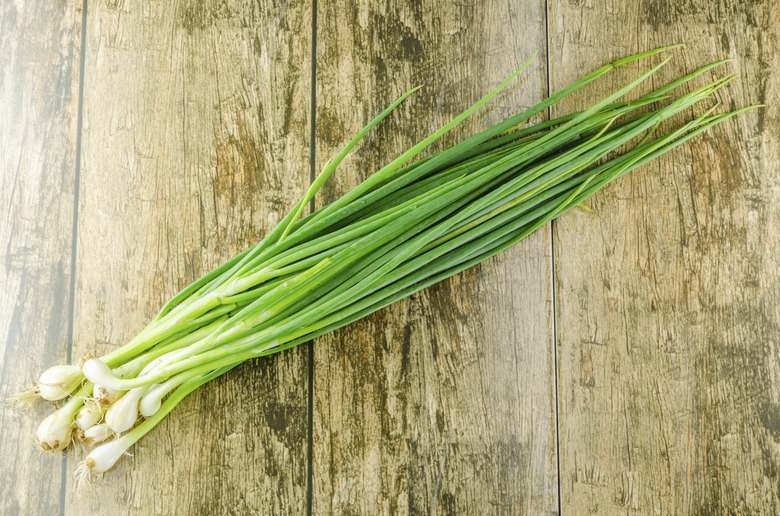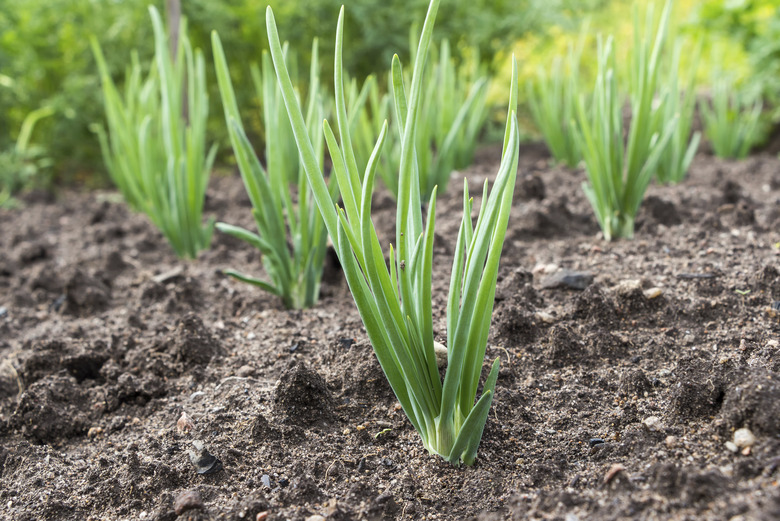List Of Onion Varieties
With so many varieties available to the home gardener, it is difficult to decide which onions (Allium spp.) to plant. Fortunately, several varieties can be grown at the same time. Grow red onions to add color to salads, sweet onions to add mild flavor when cooking and bunching onions for snacks.
Onion Species
Bulb-forming onion varieties (Allium cepa) are annual plants that are pulled from the soil when their bulbs are ready for harvest. The bulbs generally take two to four months to mature, but some varieties mature more quickly while others take longer. True bunching onions or scallions (Allium fistulosum) grow as perennials in U.S. Department of Agriculture plant hardiness zones 6 through 9. Any bulb-forming onion variety can be harvested as green onions within 30 days after they were planted as sets or plants, or 40 to 50 days after their seeds were sown. Most onion plants are either "short-day" or "long-day" varieties, although some are "mid-day" or "day-length neutral."
Short-Day Varieties
Short-day onion plants require about 12 hours of daylight each day to form bulbs. Grow short-day onions during fall and winter in USDA zones 6 through 10. Plant them when temperatures range from 55 to 75 F. Short-day varieties include:
- 'Red Burgundy' (Allium cepa 'Red Burgundy') produces sweet, mild, red, cooking onion bulbs that are ready to harvest 95 days after planting. The bulbs are 4 inches in diameter with red skin and white, red-tinted flesh. They stay fresh in cool storage for months, which is unusual for red onions.
- 'Yellow Granex', 'Maui', 'Noonday' or 'Georgia Sweet' (Allium cepa 'Yellow Granex', 'Maui', 'Noonday' or 'Georgia Sweet') are sweet yellow onions that are similar to 'Vidalia' onions (Allium cepa 'Vidalia') but are ready to harvest sooner. 'Yellow Granex' onion bulbs are ready to harvest after 80 to 109 days while 'Vidalia' onion bulbs need about 160 days. 'Yellow Granex' bulbs appear flattened and are 3 to 4 inches in diameter.
- 'White Granex' or 'Texas Sweet' (Allium cepa 'White Granex' or 'Texas Sweet) produces sweet, mild, salad onion bulbs that are ready for harvest in 100 days.
- 'Crystal White Wax' (Allium cepa 'Crystal White Wax') has pearl onion bulbs that can be pickled or put in soup or stew. They are ready for harvest after 60 days when they are 1 inch wide.
- Short-day onion plants require about 12 hours of daylight each day to form bulbs.
- Plant them when temperatures range from 55 to 75 F. Short-day varieties include: * 'Red Burgundy' (Allium cepa 'Red Burgundy') produces sweet, mild, red, cooking onion bulbs that are ready to harvest 95 days after planting.
Long-Day Varieties
Long-day onion plants require roughly 14 to 15 hours of daylight each day to form bulbs. Grow long-day onion plants in spring and early summer in USDA zones 3 through 7. Sow their seeds when the soil warms to 50 F. Plant sets two to four weeks prior to your area's last average annual hard frost date in spring. Long-day varieties include:
- 'Red Wethersfield' (Allium cepa 'Red Wethersfield') onion bulbs are 4 to 6 inches in diameter with a deep-maroon skin and pale, pink flesh. They are sweet and can be added to salads or used in cooking. They are ready for harvest 100 to 115 days after planting and store well.
- 'Yellow Ebenezer' (Allium cepa 'Yellow Ebenezer') onion bulbs are 2 ½ to 3 inches in diameter, pale yellow, mild-flavored with crisp flesh and used in cooking. They are ready for harvest after 100 days and store well.
- 'Snow White' (Allium cepa 'Snow White') produces sweet, white bulbs that grow in long- or short-day climates. They are ready for harvest after 90 days.
- Long-day onion plants require roughly 14 to 15 hours of daylight each day to form bulbs.
- They are ready for harvest 100 to 115 days after planting and store well.
- *
True Bunching Onions
Bunching onions or scallions do not have day-length requirements. They are also known as multiplier onions because they will reproduce and spread by forming offsets. Bunching onions are eaten raw straight from the garden, sliced and added to salads or used in cooking.
- 'Red Beard' (Allium fistulosum 'Red Beard') is a bunching onion that has a little red close to its base and is ready for harvest after 45 to 85 days.
- 'Evergreen White Bunching' (Allium fistulosum 'Evergreen White Bunching') is a bunching onion that produces mild, green bulbs that can be harvested after 70 days.
Growth Requirements
All onion plants require full sun — at least six to eight hours of direct sunlight each day. They are not particular about their soil, but it must be loose and drain quickly. Mix a 1- to 2-inch depth of compost into the top 6 inches of soil before planting or sowing onions.
- Bunching onions or scallions do not have day-length requirements.
- They are not particular about their soil, but it must be loose and drain quickly.
- Mix a 1- to 2-inch depth of compost into the top 6 inches of soil before planting or sowing onions.
Sweet Onion Varieties
In 1933, the Texas Agricultural Experiment Station started breeding onions to generate a sweet onion to rival the Bermuda onion, as the quality of Bermuda onions planted in Texas had declined over the years. Bermuda onions are also known as purple onions. To guarantee the red onion is sweet, it is better to grow your own. White Granex, or the Miss Society, onion is a white sweet onion that is considered a short-day variety. The flat bulb known as the White Bermuda is another short-day variety that has sweet flesh. These onions offer a mild flavor and are suitable for grilling or eating fresh. The soil should be tilled to a depth of 12 inches and worked with well-rotted manure. Sets are spaced about 3 inches apart.
- In 1933, the Texas Agricultural Experiment Station started breeding onions to generate a sweet onion to rival the Bermuda onion, as the quality of Bermuda onions planted in Texas had declined over the years.
- White Granex, or the Miss Society, onion is a white sweet onion that is considered a short-day variety.
Tip
Onion bulbs harvested when temperatures are cool usually are sweet, and bulbs harvested when temperatures are hot have a more powerful flavor.
References
- Ohio State University Extension: Growing Onions in the Home Garden
- Floridata: Allium Cepa, Cepa Group
- Harvest to Table: How to Grow Onions
- The Ohio State University Extension Office: Growing Onions in the Home Garden
- University of Illinois Extension: Onion
- Texas A&M University Agriculture Department: The Onion That Came to Texas but Never Left The Same
- University of California Vegetable Research and Information Center: Onions
- National Gardening Association: Onion Varieties
- Calabria From Scratch: Cipolle di Tropea (The Sweet Red Onions of Tropea)
- Texas A&M University Agriculture Department: Short Day Varieties




